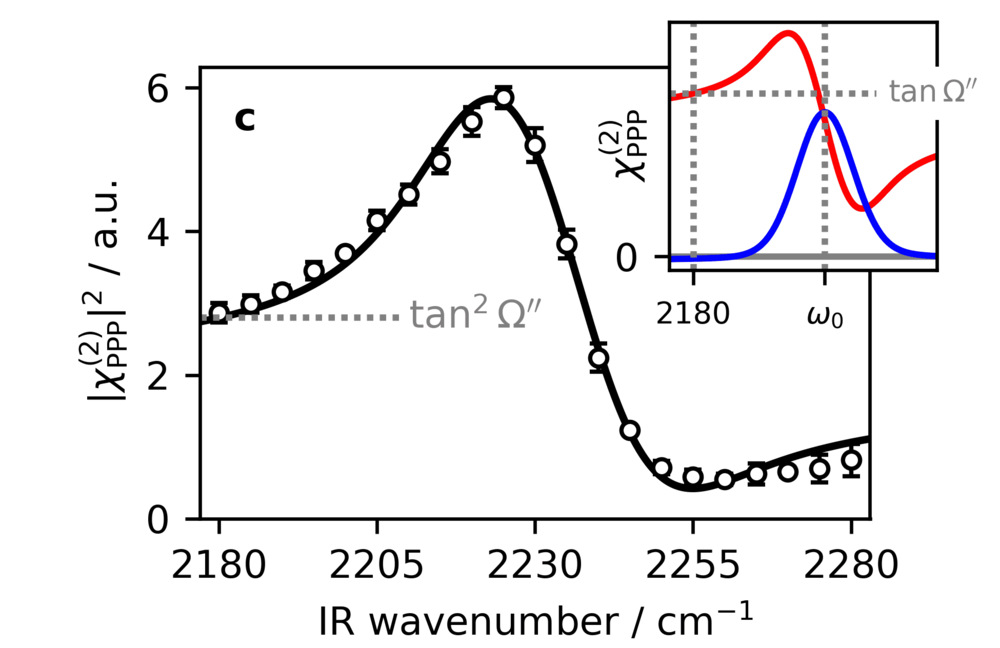publications
Sum Frequency Dual Null Angle Approach and its Use in Surface Hyperpolarizability Ratio Measurements
Published on: Journal of Physical Chemistry, Editor’s pick
Publication date: 20250826
Introduction
Accurate understanding the electronic structure at buried interfaces is a longstanding challenge in surface and interfacial science. While modern techniques can probe such information, they often rely on the assumption that a molecule’s electronic structure at the interface is the same as in bulk environments like liquids or gases.
However, this assumption doesn’t always hold true. Interfacial environments can significantly different that of the bulk phase. Therefore the molecular properties we calculated based on such assumptions can be inaccurate.
To overcome this limitation, we recently developed a method to extract the surface hyperpolarizability—a key molecular property that governs how the interface responds to light—from SFG measurements. By collecting SFG data under three polarization combinations, we can solve for the surface hyperpolarizability ratio in a way that is independent of molecular orientation. This method is prove to be more accurate compared to conventional methods as it does not make the assumption that bulk phase electronic structure is similar to the interface electronic structure. With this study, we were able to prove that the electronic structure at the ‘air-water’ interface is significantly different from the bulk phase.
Simplified summary of the first project
(as told in a three minute theses (3MT) presentation)
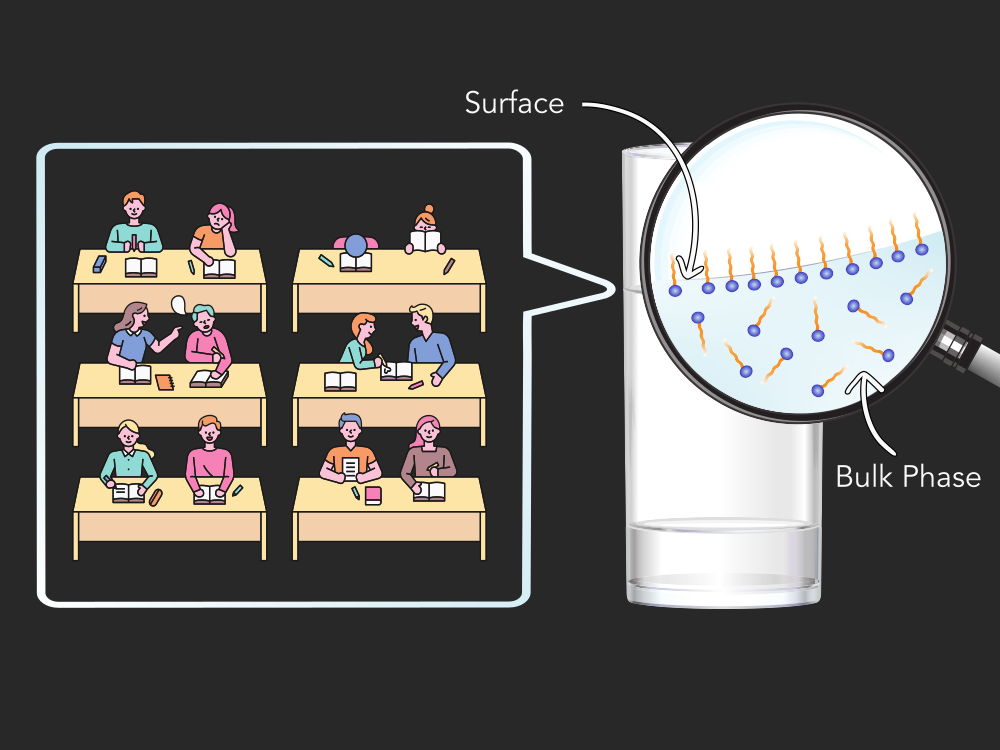
Do you remember sitting in the back of a classroom like this, and chatting with your friends? But, if you sat in the front row, that’s a completely different experience—You’d likely be paying attention the entire time.
A molecular system, on the other hand, behaves exactly the same way. At the surface, molecules are arranged in a single direction, but in the bulk phase, they are randomly arranged. Can be quite frustrating for a teacher but really interesting for a chemist. Because having been able to control the arrangement of these ‘front row molecules’ leads to wonderful applications.
The Problem
And, the standard model, our current rulebook, can predict these molecular behaviors with remarkable precision. But there are still some gaps of understanding. One big challenge is to figure out how these molecules are arranged at any given moment.
Imagine billions of molecules in a tiny classroom—there’s no way to know exactly how they’re lined up.
But, without this information, it’s impossible to simulate surface behavior.
With no better solution, the standard model uses bulk phase properties to simulate the surface. But this approach is full of uncertainty. Just like students at the front are having a completely different experience, chemistry at the surface can be completely different from the bulk phase.
How did we approach it?
Our first project fills these gaps in understanding and goes beyond the standard model. Instead of using bulk phase properties, we focused on extracting properties directly from the surface itself.
But how can we do that without knowing the exact molecular arrangement? Our solution–is a model that does not rely on molecular arrangement at all. So that we can extract surface properties with zero uncertainty and much greater accuracy.
A New Challenge
The next step of this study was to expand our studies into analyzing and extracting information from buried interfaces as such interfaces play a key role in many application, including pharmaceuticals, biochemistry, environmental science and materials science. However, extracting important quantitative parameters (like molecular orientation or hyperpolarizability ratios) is notoriously difficult at buried interfaces due to:
Comparing signals collected in different polarizations requires careful intensity calibration, which is relatively straightforward for air–solid or air–liquid interfaces but much harder for buried interfaces.
- To interpret the results unambiguously, the relative signs of the vibrational response amplitudes must be known.
- Complicated analysis at buried interfaces due to refractive index mismatches
- Dependence on assumed molecular orientation distributions
Our goal was to design a method to bypass these limitations—specifically, to obtain the surface hyperpolarizability ratio from SFG spectra using a fully experimental calibration approach that could be applied even at buried or optically complex interfaces.
The reason to use sum frequency generation for this study was due to its unique ability to selectively extract information from interfaces.
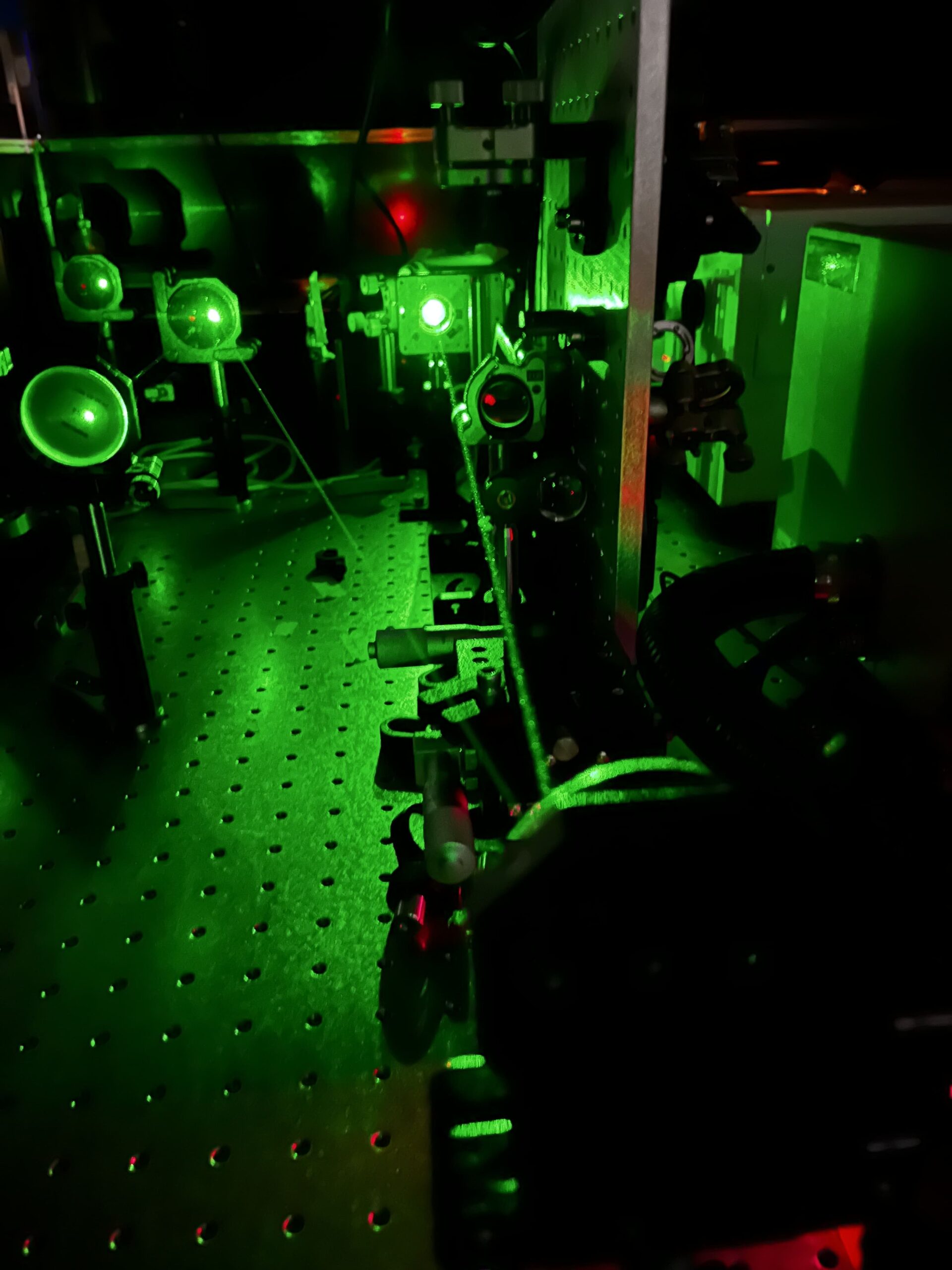
What is Sum-Frequency Generation (SFG) Spectroscopy?
- SFG spectroscopy is a nonlinear optical technique used to study surfaces and interfaces. It works by sending two laser beams (infrared and visible) at a molecular surface.
- If the molecules at the surface lack inversion symmetry, they generate a unique optical signal.
- This signal provides information about molecular structure and orientation at the interface.
SFG is interfacial selective
- SFG optical process that only occurs in non-centrosymmetric environments—making it inherently selective to interfaces, where molecular symmetry is broken.
- No Bulk Signal Interference: In centrosymmetric bulk phases (like most liquids and solids), the SFG signal cancels out, ensuring that the detected signal originates only from the interface.
Our Experimental Approach
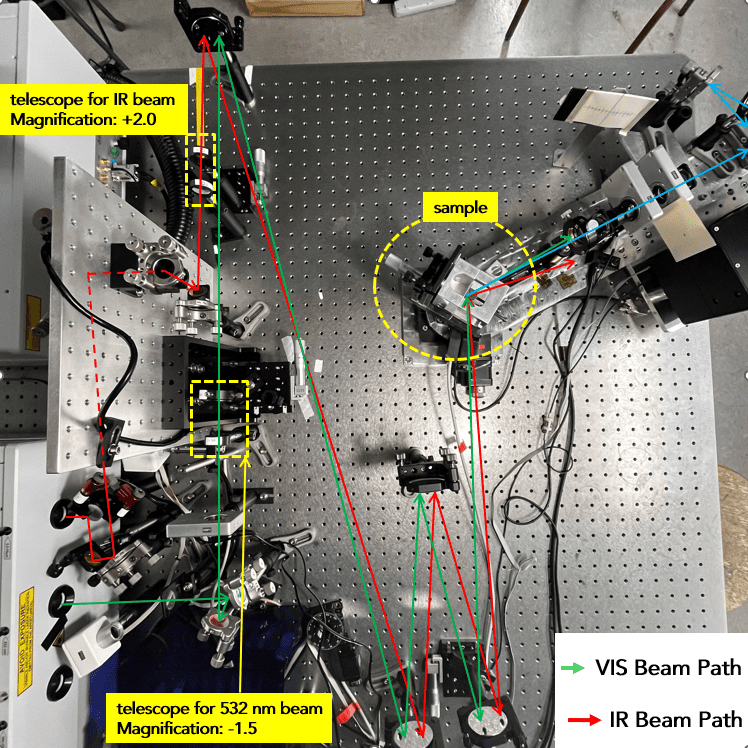
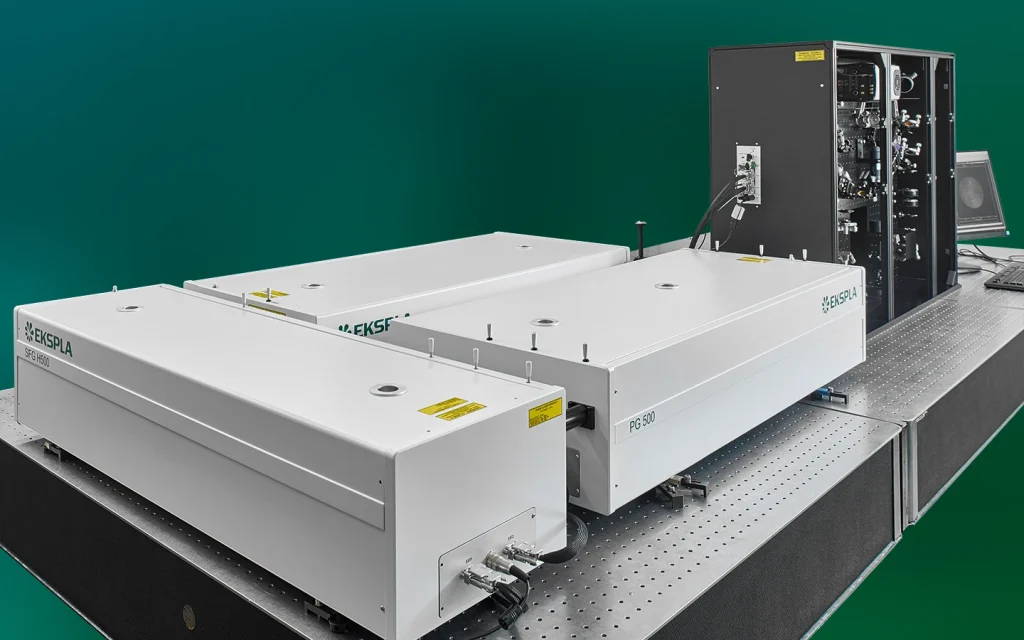
Our work primarily revolves around sum frequency generation spectroscopy, along with Raman and infrared spectroscopy.
What sets our approach apart is a strong emphasis on custom-built instrumentation. Instead of relying solely on commercial systems, we work hands-on in designing and building our own setups, which we control directly through Python programming language. This DIY and programmable approach gives us the flexibility to tailor high-end spectroscopic instruments precisely to our experimental needs.
On the right is the commercial picosecond scanning Sum Frequency Generation (SFG) vibrational spectrometer (EKSPLA), and our custom-built optical configuration designed specifically to probe buried interfaces. By combining high-end commercial components with tailored optical design, we achieve the precision and flexibility required for specific tasks.
Dual Null Angle Experimental Setup
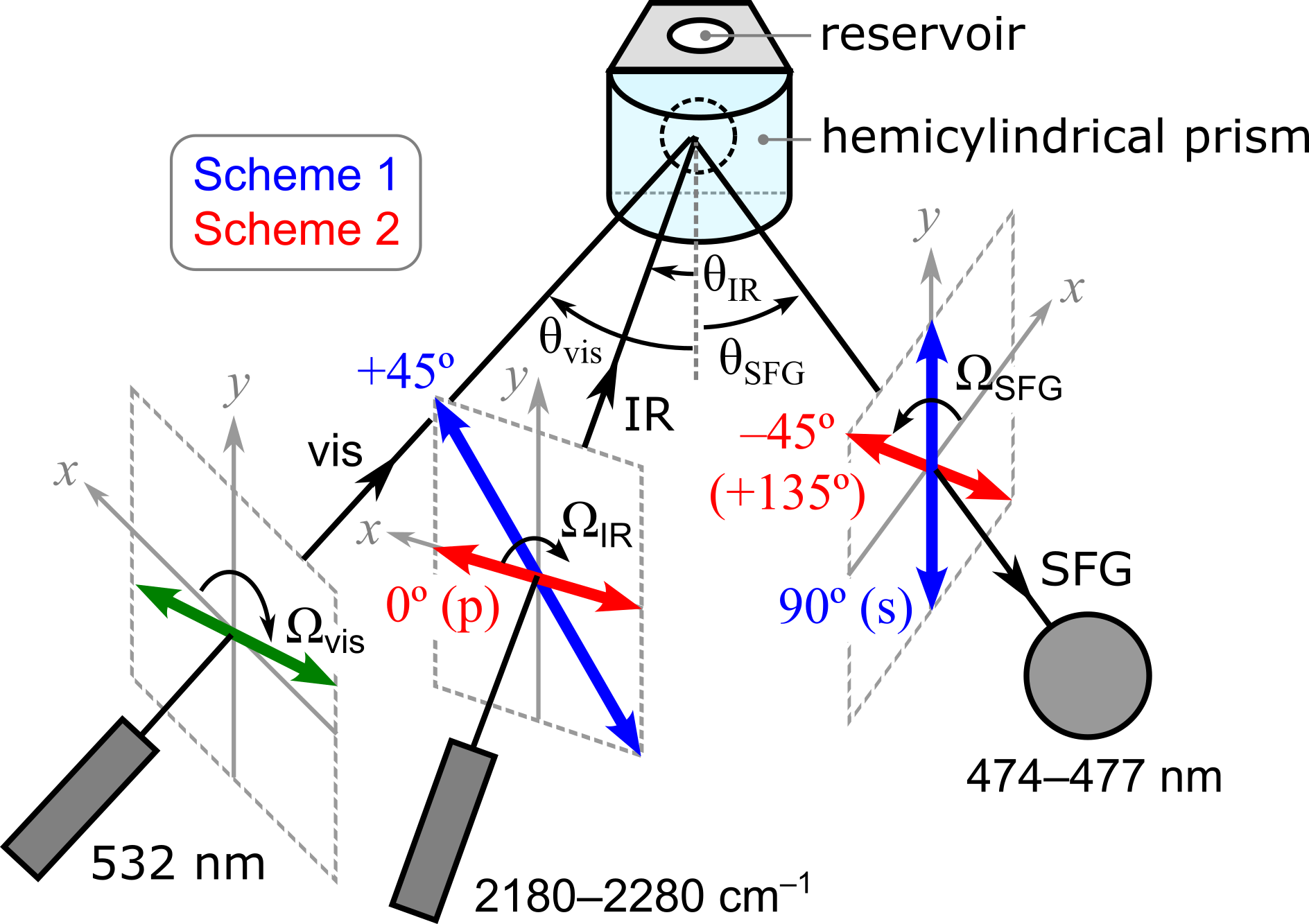
The null angle methods have been previously discussed in other publications. However, to our best knowledge, it has not been used to calibrate a buried interface. This novel ‘dual’ null angle method that we introduced goes beyond the conventional null angle methods and provide accurate molecular information at the interface.
We extended the traditional null angle method in SFG—where one beam is polarized at ±45°—by introducing a second complementary null angle configuration. The two schemes are:
- Scheme 1: IR beam at ±45°, SFG beam fixed at P (0 degrees)
- Scheme 2: SFG beam at ±45°, IR beam fixed at P (0 degrees)
By performing measurements across both schemes, we were able to:
Calibrate the relative intensity between different polarization combinations using null points in polarization rotation scans.
Determine the relative phase (i.e., sign) between different non-linear susceptibility tensor components—critical for calculating the surface hyperpolarizability ratio.
Apply this framework to both ideal systems (quartz) and buried interfaces (CaF₂-water with cyanophenol).
Methodology
- First, as discussed, SFG experiments were conducted using a tunable picosecond laser system, for two experimental configurations.
- Beam polarizations were modulated with high precision using wave plates and a Berek compensator, and intensity data were collected while sweeping the azimuthal angle of the visible beam.
- Two null angles (Ω′ and Ω″) were extracted from the angular intensity profiles, enabling calibration without external standards.
- Full spectral fitting was performed using Faddeeva functions to separate resonant and non-resonant components and validate the extracted amplitudes.
Key Results
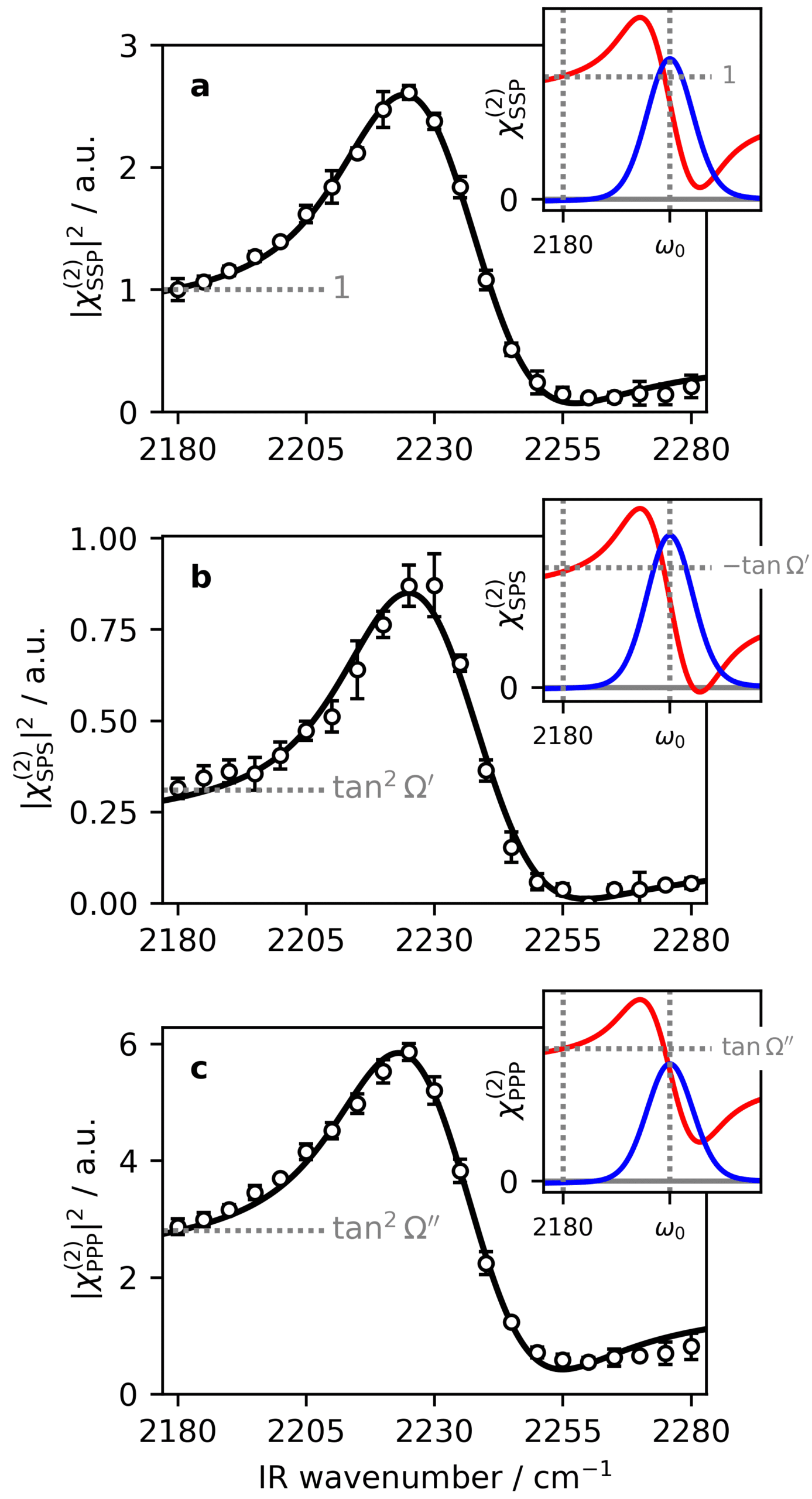
- Demonstrated that the hyperpolarizability ratio (R_surface) can be obtained independently of molecular orientation distribution, a major advancement in the field.
- At the CaF₂–water interface, we measured R_surface ≈ 0.13 ± 0.02, significantly different from bulk-phase values, showing that electronic structure at interfaces can deviate from expectations.
- Achieved accurate calibration and sign determination using only intensity measurements—no heterodyne detection or molecular dynamics simulations required.
Spectra of p-cyanophenol adsorbed at the surface of CaF₂ from a 75 mM solution, with experimental data indicated by points. Relative intensity values in (a) SSP, (b) SPS, and (c) PPP polarization schemes were calibrated using the novel dual null angle measurements performed at 2180 cm⁻¹. The insets show the real (red) and imaginary (blue) components of the effective susceptibility obtained by the fitting.
This dual-null approach provides a new experimental standard for interfacial SFG studies, especially at buried or technologically relevant interfaces where conventional calibration is impossible. It enables more rigorous comparisons between systems and paves the way for applying SFG to new material surfaces, biosensors, and energy interfaces.

